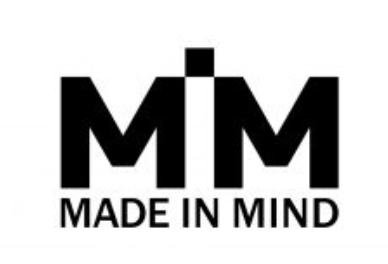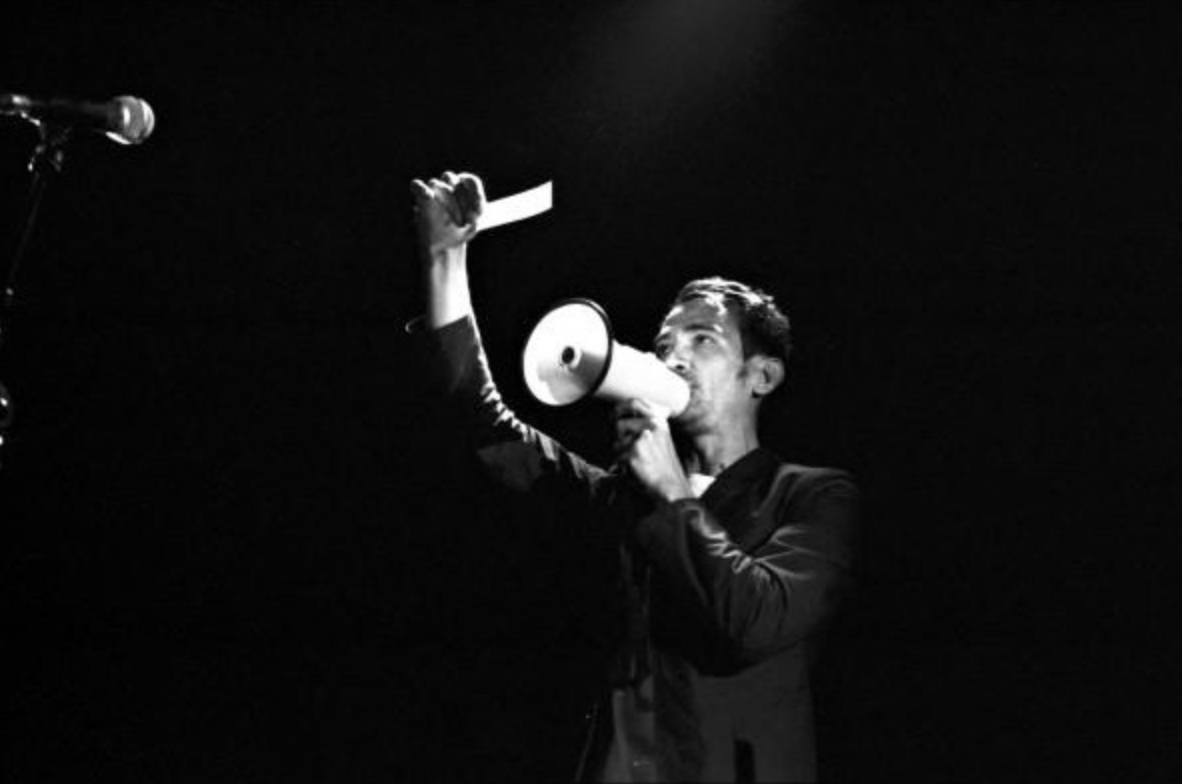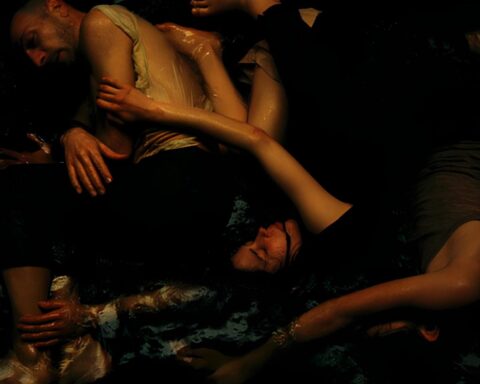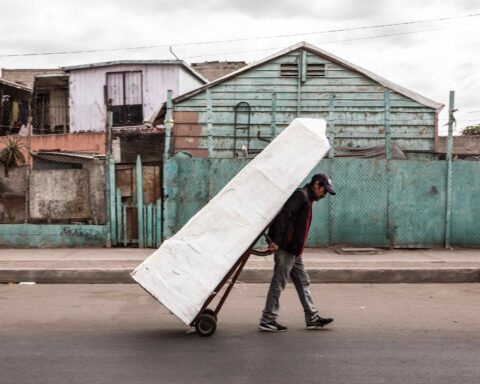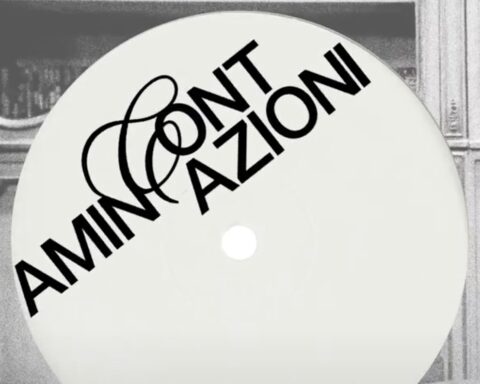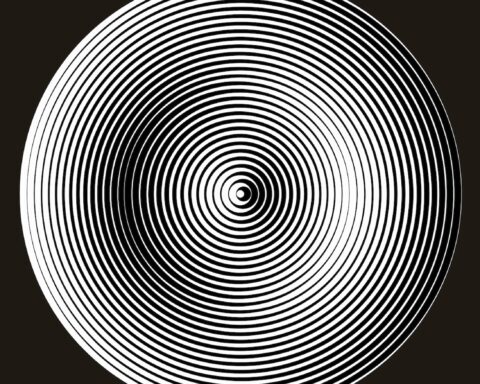Anne-James Chaton, writer and multi-faceted plastic artist, started her practice at the end of the 1980s – beginning of the 1990s in the Parisian literary scene, a moment qualified as “post-poetic” and “trans-genre”. In a desire to go beyond the question of lyricism and make the object speak by itself, he will take an interest in collective, shared and banal scriptures, which he will call “poor writings”. Chaton began to work with the music scene of the early 21st century – from experimental rock to electronic music. In doing so, he brings the language object into its full materiality through the voice, compromising the timbre and the body, while signaling to the sound universe that accompanies him during his performances. With a writer’s canvas [as he would like to point out], Anne-James Chaton’s “raw” language and sound material reminds us of the spoken voice. He is most often labelled a “sound poet”, however, it is the context and the listener/spectator who ultimately determines the status of his practice, or even of his object. This, rendered during its staging, is seen as a living organism capable of spurring meaning. The listener, involved in the communication process, acts directly in the language game through the action of listening.
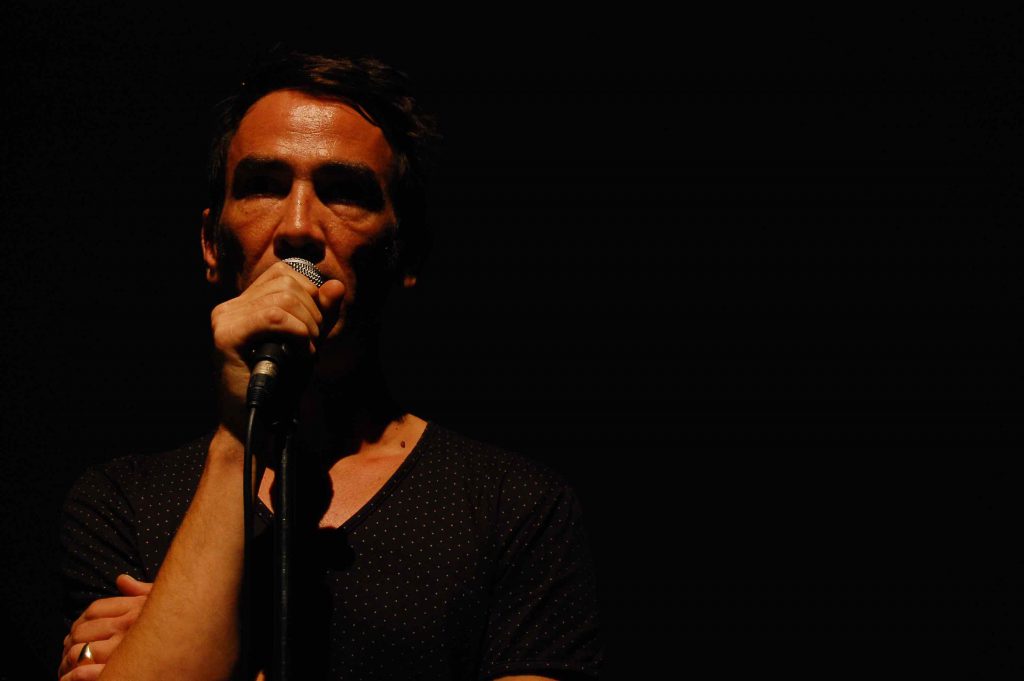
Coral Nieto Garcia: When you started writing and performing accompanied by Andy Moor, Thurston Moore, Carsten Nicolai aka Alva Noto, did you call yourself a sound poet yet?
Anne-James Chaton : This is a reflection I had with Alva Noto when he asked me to join his Raster Noto label. We decided together, when we presented the work officially, that we were not going to say that it was sound poetry so that we could open up the spectrum of possibilities and not limit listening. In this way, we realized the different regions during the reception: they quickly identified the literary provenance of the object, its connection, according to their own understanding of contemporary poetic forms. For example, North America perceived literary provenance having to do with the Beat Generation or spoken words, while, in Germany, in Asia, in South America for them it was very experimental, so it was like electronic music today.
CNG: How should we call the “objects” that the spectator/auditor hears during your performances: “sound objects” or “language objects”?
AJC: It is about the sound turning into language. In the manufacturing process there is only text, everything is generated by writing. So it’s a writing carried out by the voice and then put to a machine. So the whole thing is just an amplification of the texts. It is a language object that involves the modeling of the cuisine of sound poetry. The object and the ear are potentially both acoustic objects. An illustrative example is It’s gonna rain by Steve Reich: is it a language, sound, or human beatboxing object? These are classifications by genre or style that are subsequent to the object itself. Plastically, in terms of sound, they are very close. One can become the other. It’s up to you to follow up from one to the other! For example, when I read Evénement, I try, by means of a rather cold diction, not to capture the attention of the listener’s ear by an intonation. Otherwise, it would remind him too forcefully that there is a sense to which he should attach himself in a primary way compared to the other elements of the object. This creates a form of “fatigue” or weariness in the listening experience. It is more than a mere sound presented to the listener, so it is a sound object which can become a literary object again thanks to the loop whose principle is to create a straight line and it is up to the listener to create a bend around it. This way the auditor creates oscillations: he hears the text, he hears another layer since the text has become sound and then it eventually evolves into phrasing. The whole point with these objects is that eventually they will break free from their shell to become another object in relation to other things. It is a multifaceted starting material.
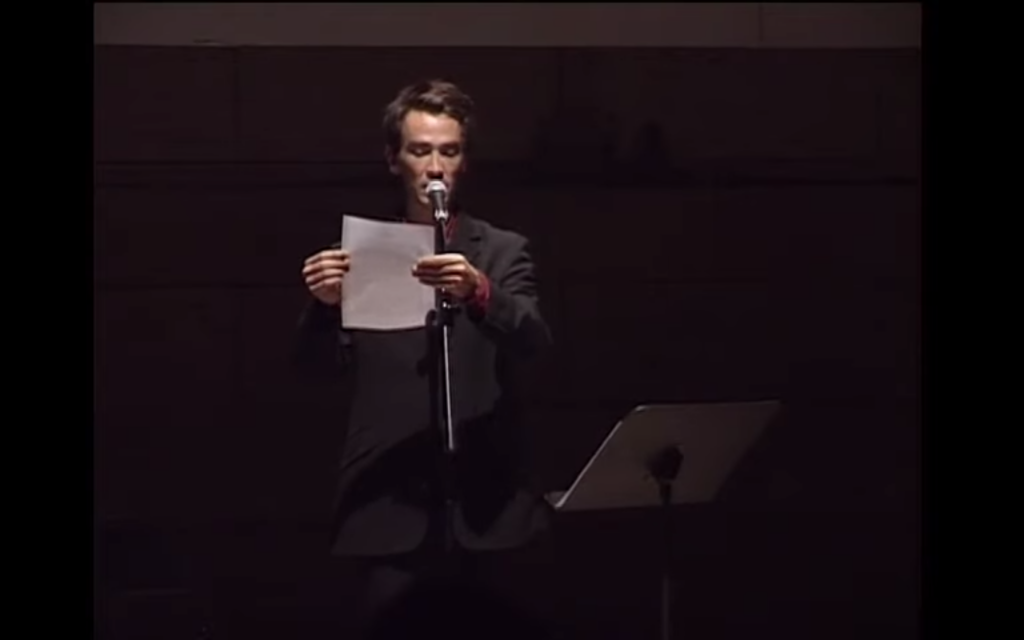
Performance in PROPOSTA Barcelona, Spain, 2001
CNG: And what do you mean by “object”?
AJC: It is an object that is perceived through a medium, so it is physical. If it has sound diffusion, it becomes an object from which something else will be able to arrive. It will gradually be defined according to the way in which it has been reappropriated: linguistic object, poetic object … so that the qualities which can be attached can be multiple. It is akin to a prism that can change depending on the context (from the bookstore, contemporary art center to the electro box, rock…) The “sound object” is the most generic way of circumscribing it without overloading it. Listening will be completely different because of material issues: the same object in a bookstore remains a poetic object, while in an electronic festival it becomes an electro object. The technique is unending.
CNG: What relationship do you have with music (structural, fusional, interactional…) ?
AJC: I don’t have a musical ear. My relation to music is from writing, text and voice, even if the rhythm is present. But it’s up to the musicians to bring the musical scope. From a technological standpoint, I will use the same instruments as them (techniques borrowed from electroacoustic music like sampling), but not in the same way. Next is the question of musicality which is specific to language. Poetic language has always asked the question of rhythm and musicality. It becomes music from the moment it enters a writing canvas. My writing canvas is always a canvas that I take or that I make, but which comes from the order of literature, poetry or not. I write music with a writer’s canvas; a musician has his own. This is what sounds so strange to the ear. This strangeness comes from the fact that literature is set to music with the tools of the musician, and this creates a form that one can think of as musical, but when you dig deeper you realize that these are literary rhythms. It is either the reader or the listener who makes the choice to leave, to move from one domain to another.
CNG: What do you think about the fact that poetry beckons to music?
AJC: There is a certain lyricism through the voice which re-emerges. When I got to writing at the end of the 80s and beginning of the 90s there was this post-lyric desire to erase lyricism, a movement led by some writers working together for magazines like TXT. It is a corriente post-marxista that carries out both restructuring the great history of the avant-garde and the theorizing of their own practices. They tried to do away with hierarchical structures, to think on a more horizontal plane. And one of the elements of this positioning was not to develop a meta-discourse about their own objects. It was a political choice for the poetic field of the time. A decision not to articulate a second language on an object which presented itself in its extreme materiality, at the risk of excluding possible perceptions.
I pondered what was the writing that was going to drop me outside, as far as possible from a potential reinvestment by the subject. The question suddenly was what are the most shared writings: the collective scriptures that we consume every day and that we do not read. For example, a ticket is a material object that everyone is constantly using. The experience gained is that we are used to this writing format as we assume to already know what it contains, so there is an instance of “flash reading”. It allows me to move away from the text while continuing to create literary devices. However, I soon came to realize that the ticket was already in itself a story, not just a portrait, that is to say a very visual even plastic way of approaching it, but the idea of unity of action, of a tone … In recent years, we add relevant personal details to the tickets. As a result, it is not so cold, objective writing … over time it has become quite the opposite.
Then, there is the question of the timbre, something concrete, and therefore impossible to abstract.
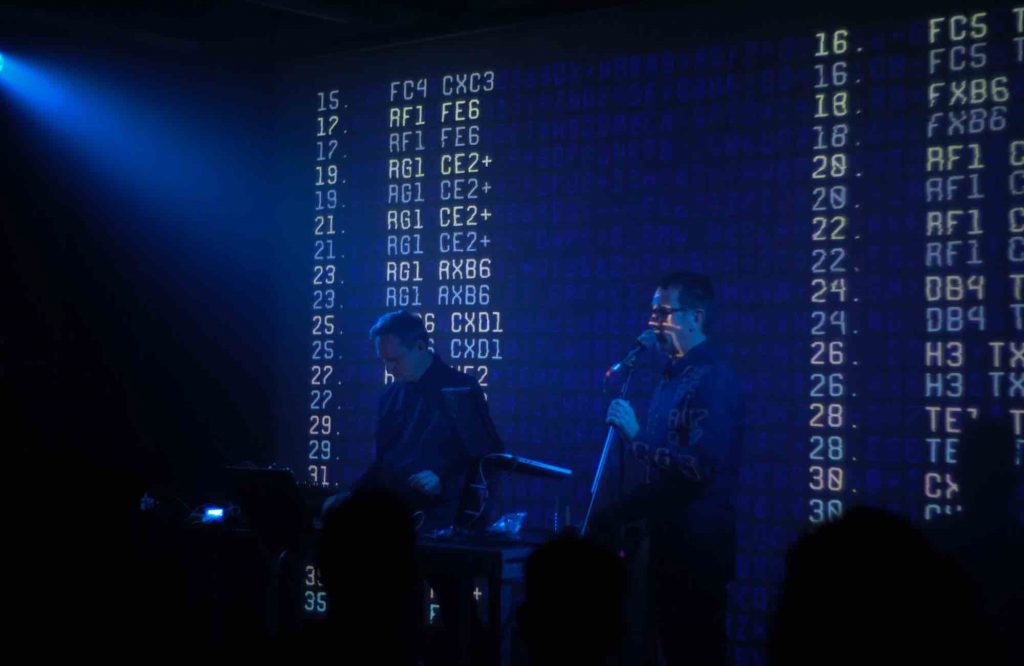
Performance with Alva Noto
CNG: How do you proceed from the collecting of sounds and verbal material during the process of creation to the actual performance? Is there a kind of “carnal relationship” when dealing with the rhythms of our daily lives as they disturb our hearing and awaken our senses which have grown numb?
AJC: As soon as you go on stage you have to reconstruct the object. There is a physical application which is constitutive of the object and which will vary according to the contexts: the attention given to the body will not be the same depending on the location. The tension it creates is not the same, it will depend on the sound, people … The body is there with a given state. Accidents and incidents can arise. It is important to have the text with you to signify the relation to writing, and then the possibility of rewriting the object. The musician has a memory relationship with their texts; I have a physical relationship with the language and this leads to this possibility of making the object, because it has a direct impact on the object itself. As a result, in a given moment a listener or a spectator will say “he is in the range of performance, or poetry or music…” My state of mind at that moment leads to another relationship with the object. And that too can alter the definition of what it is.
CNG: How do you understand this process of “voice abstraction”, from the moment the subject and with it the affections of the sender disappear, resulting nevertheless in an “object” (sound object and/or language object) due to its physicality and its specific material?
AJC: We play on the level of the dichotomy between the abstract and the concrete: first of all there is the fact of working on a textual matter, very concrete but of the collective order. Also there is a desire to distort this matter by seeking colors by way of intonation (at the level of meaning). Afterwards, it is the resistance of this textual material itself. And then there is the desire to abstract the voice by a rhythm which would be a very monotonous rhythm, knowing in advance that it does not work because the timbre (the signature of the issuer) is always there.
CNG: What are the poetic processes that define your act as a poetic one? How did the collaboration with the music scene lead you to explore the different modalities of the voice, to new types of writing and rhythms?
AJC:Having accomplished so much in recent years is what turned this novel form into a reality, a form that is in itself a questioning of what it comprises. Once the sound catches up to the form, the rhythm of the language and sounds becomes constitutive of the overall form of the piece. So the sound reacts to the text, it modifies the form of the narrative and therefore the text turned into sound. Guillaume Apollinaire said “poetry will be sound”. In doing so, I am less in a protosyllabel or syllabic rhythm than in a form of memory of the spoken voice.
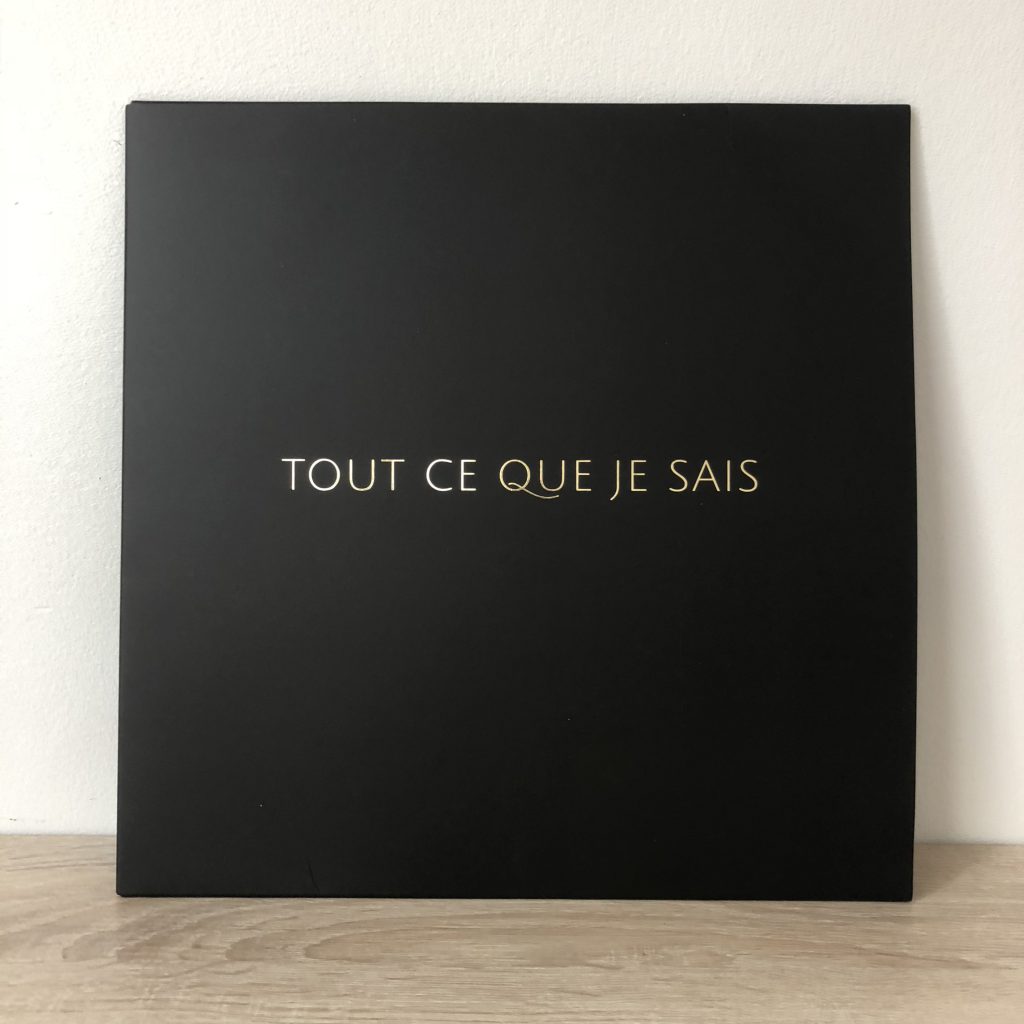
ed. Unsounds, CD + LP, 33 T
In France, we turn to the spoken word more than to the machine. We do not feel that there is a partial becoming of the text because we are quick to perceive it as a voicing of the text. We can see its density written on the page, but the text on the page has not been distorted because it will have gone through machines to return to the page. My texts that are published are originally conceived as sound. The final form, the published version, has been somewhat distorted by having gone through another medium. It is quite different from a writing that went through a sound software or was amplified. Visual arts imply a multimedia approach and the textual forms that emerge as a result can qualify as objects of sound poetry unbeknownst to the artists themselves.
CNG: How is the communication process carried out in your practice?
AJC: The way in which I work in loop with a fragment of sentences leads to a game of compression and segmentation of the language: the sentence itself is compressed in a segment which is compressed again by the speed that impels the machine (the sample). This compression process created on a type of writings with a communicative function, such as the newspaper, will trigger two things: on the one hand, “boredom”, the moment from which communication begins because the listener, starting with the aspect of sound, can return to the linguistic object, and thus create communication at the very same time when the language itself is being multiplied. On the other hand, a second phenomenon specific to the mechanical nature of the work itself, what is called “the ghost word”: because of the weariness and the somewhat extended duration, one gets the impression that new words are appearing. In doing so, the fact of producing an open communication full of misunderstandings leads to a multiplication of meaning, and therefore the impossibility of a complete and closed understanding. However, this opens up a new possibility for the listener, that of creating another meaning for himself, and thus of creating language. Indeed, it is from these accidents that a telescoping of meaning happens The poetic function of language is there: my language can multiply into other languageseach with its singular properties. Jacques Derrida, in his critical to the will of understanding, stated that when there is a problem inside the expression a collective can be born. In the writing of the word “différance” it points to where it leads. You can’t hear it but you can read it, setting off an explosion of meaning within the writing itself. Furthermore, it is the notion of the “graph” that interests me.
CNG: How would you assess the importance of listening as an action? How can the listener play an active part during the communication process and therefore in the constitution of language?
AJC: Only the listening ear has the possibility to dissociate or relate the components of the musical piece. To reach this objective, you initiate a monotonous, very dry and cold reading mode that can be seen as a soundtrack, a bass line with the possibility of becoming a total sound. Speech and language are also full frequencies.
I have a very material connection to language. In the act of repeating the same form of writing, you barely move it, it remains nailed in place, yet it moves ever so lightly. During the accident, the error, another language is possible and it gives leaning on whole. Besides, when I set up the sampling, I don’t aim to sign for anything in particular. We know that it refers to something, but I try to free language from its material attachment. Not to ignore reference, but to move beyond.
CNG: Do you consider that concepts such as “literature” and “orality”, remain intact in our modern days?
AJC: What literature? Isn’t a sales receipt literature? Why wouldn’t it be? Literature is still alive and everywhere. It’s up to listeners and researchers to say: this is literature. Everyone defines it according to how they self-appropriate a certain type of text: everyone makes their own literature according to their relationship to language, whether or not mediated by literary objects or musical objects. In the Revue de littérature générale (General Literature Review) directed by Olivier Cadiot and Pierre Alféri, these propositions were qualified as “OVNI” (Unidentified Verbal Objects). Objects are made to circulate and be reshaped and perceived differently. We must not impose speech.

